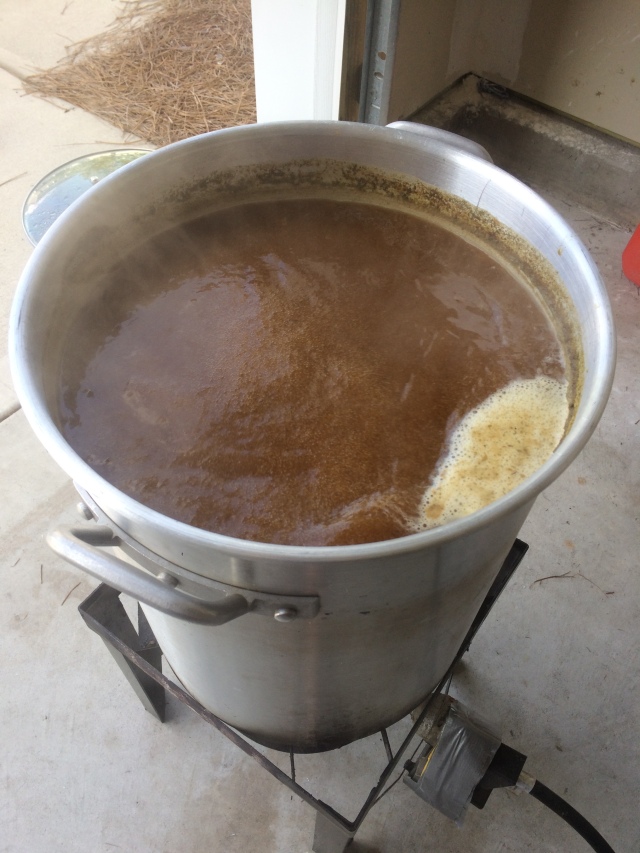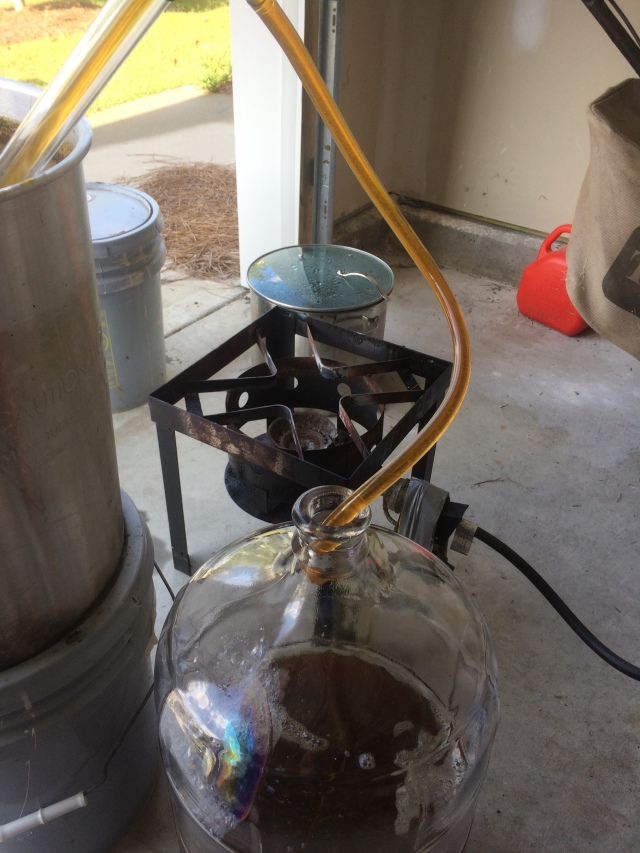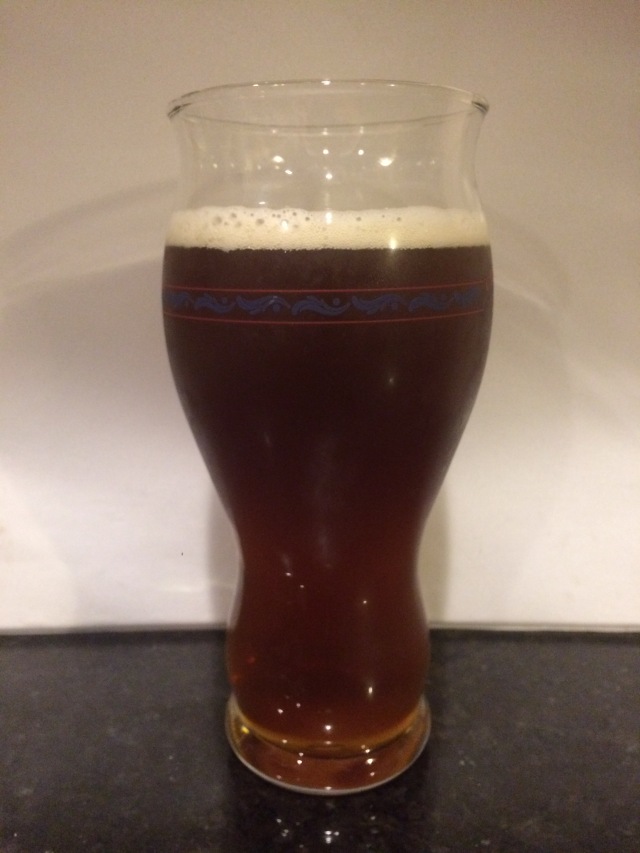This post is one in a series of making small adjustments to a single recipe in order to improve it, learn more about the impact each ingredient has on the finished product, and the art of recipe creation. The rest of the series can be found here.
Brew Day
A Monday holiday gave me a brew day I wouldn’t have had otherwise. However, life still happens, and since I didn’t have a five-hour block of time to devote to brewing, my mash beat the sunrise. I pulled my first runnings and mixed in my sparge water before leaving for a little over four hours. When I returned, I picked up as if I hadn’t left and had no issues—except an almost-stuck sparge when I drained my second runnings. I imagine the grain bed had settled much more than normal in the length of time I let my (quite fine-milled) mash sit.

After checking my pre-boil gravity, I knew I was going to come in a little high on my OG—just how high would depend on my boil-off rate, which is unfortunately only consistent within a given range for my setup and not a set number (outside brewing and a climate that is sometimes extremely humid are factors). Because of this, I could not calculate with any certainty the amount of water I’d need to add to hit my target gravity until after I finished the boil. Once my wort was cooled and gathered, though, I was only four points higher than my target—much better than the ten points higher that I’d calculated during the boil, accounting for the high end of my boil-off rate.
I topped off to hit my target gravity (something I haven’t done since my extract days), cooled my wort to the desired temperature, and pitched my yeast. The brew day that had begun before the sun ended around 4:00. The next morning, early signs of fermentation had begun.

Recipe
A few differences between Iteration 7 and Iteration 8 stuck out to me. While I was attempting to adjust the hop ratios to improve the hop profile, something was lost in the change: the apricot aroma/flavor that was, although unintended, present and delightful in Iteration 7. To be honest, the hop profile didn’t improve all that much, so my reasoning behind the changes on this recipe is fairly simple. This recipe finally needed to make the step up to IPA-level hop aroma, so I decided to double my dry hopping. In deciding how to split that across the three varieties I used for dry hopping, I leaned on what I had decided for Iteration 8 regarding the hop oils and my search for more citrus flavor; however, I also wanted to bring back some of the apricot notes I had lost. These thoughts yielded this recipe:
- Mashed at 150⁰ F for 1 hr.
- 10 lbs. 2-Row
- 1.2 lbs. Crystal 120
- 1 lb. Vienna
- Boiled for 1 hr.
- 0.5 oz. Magnum (60 min) at 14.7% AA
- 0.5 oz. Magnum (30 min) at 14.7% AA
- 0.5 oz. Cascade (10 min) at 5% AA
- 0.5 oz. Centennial (5 min) at 9.7% AA
- 0.5 oz. Amarillo (0 min) at 7.8% AA
- 0.5 oz. Amarillo (hop stand at 180⁰ F) at 7.8% AA
- Pitched US-O5
- OG: 1.066
- FG: 1.011
- ABV: 7.2%
- Dry hopped 2.5 oz. Cascade, 1.5 oz. Centennial, and 1 oz. Amarillo for 4 days.
- Bottled and primed with 4 oz. of priming sugar.
Tasting
This beer poured with a moderate head and had moderate retention. The color was the spot-on red that this grain bill at this gravity has been yielding across the last several iterations.

The aroma had notes of citrus, plum, and cherry; however, the aroma was nowhere near as strong as I expected it to be. In fact, this beer had less aroma than I remember other versions of this recipe having, which is surprising due to the fact that this recipe had double the amount of dry hops as the previous version.
The flavor was as if I had taken a handful of freshly mown grass and began chewing on it. There are some off flavors that I’ve read about and the description sounds odd to me. What does chlorophyll taste like? Is the grassy off-flavor dry grass or fresh grass? Those descriptions then suddenly make sense once you taste it. My beer tasted like freshly mown grass smells.
The truth is that this grassy off-flavor was less present at this tasting than it was in the first few bottles I opened of this iteration, and I was able to taste some other characteristics as well, which wasn’t the case when I first tasted it. Beneath the grassiness, I was able to make out grapefruit with a hint of orange, plum, and cherry notes.
Goals for the Next Brew
The origin of this grassy off-flavor is bothering me. Frankly, there are a few places that it could be coming from. This recipe used more dry hops than I’ve ever used before, so I can’t be certain that the amount wasn’t at least part of the problem. If the amount is the issue, I feel fairly confident that the contact time worked in conjunction with the amount to produce the off-flavor.
Another possible source of the grassiness is the hops themselves. The batch of Amarillo I used in this brew was a different batch than I’d used before. It had a different AA% and was in a different package at the LHBS than I usually purchase (still from a reputable company). The reason I bought that was that it was the only available Amarillo in the display. I didn’t think much of it since the AA% wasn’t that different and it was the same crop year I’d been using. However, when I opened this package to toss the hops into the kettle, I noticed they were a bit darker color than I’m used to seeing in my hops and they didn’t have as strong of an aroma. The aroma wasn’t exactly “off,” but it wasn’t exactly what I thought it should be. Still, it wasn’t enough for me to definitely decide not to use them—but maybe it should have been.
Perhaps it’s a combination of all three of these things. Whatever the cause, I know that this beer needs more hop flavor, more hop aroma, and no grassiness covering up the other flavors. Additionally, the grapefruit I noted in this batch is not as pleasant to me as the almost orange citrus flavor I tasted in previous batches, and I would like to see a return to that. I’m left with these questions for next time:
- What steps can I take to avoid that grassy off-flavor?
- Should I add more hops to the kettle to get more hop flavor in addition to the hop aroma?
- How should I change my dry hop ratios to get more orange than grapefruit?
Recipe Progression
| Iteration 1 | Iteration 2 | Iteration 3 | Iteration 4 | Iteration 5 | Iteration 6 | Iteration 7 | Iteration 8 | Iteration 9 | |
| Base Malt 2-row | 10.25 lbs. | 10.25 lbs. | 10.25 lbs. | 9 lbs. | 10 lbs. | 10 lbs. | 10 lbs. | 10 lbs. | 10 lbs. |
| Crystal Malt | 1 lb. C80 | 1 lb. C120 | 0.75 lbs. C120 | 1.25 lbs. C120 | 1 lb. C120 | 1.2 lbs. C120 | 1.2 lbs. C120 | 1.2 lbs. C120 | 1.2 lbs. C120 |
| Specialty Malt | 0.5 lbs. Special B | 1 lb. Munich | 1 lb. Vienna | 1 lb. Vienna | 1 lb. Vienna | 1 lb. Vienna | 1 lb. Vienna | ||
| 60 min. hop | 0.5 oz. Simcoe | 0.5 oz. Simcoe | 0.5 oz. Simcoe | 0.5 oz. Simcoe | 0.5 oz. Simcoe | 1 oz. Magnum | 0.5 oz. Magnum | 0.5 oz. Magnum | 0.5 oz. Magnum |
| 30 min. hop | 0.5 oz. Simcoe | 0.5 oz. Simcoe | 0.5 oz. Simcoe | 0.5 oz. Simcoe | 0.5 oz. Simcoe | 0.5 oz. Magnum | 0.5 oz. Magnum | 0.5 oz. Magnum | |
| 15 min. hop | 0.5 oz. Cascade | 0.5 oz. Cascade | 0.5 oz. Cascade | 0.5 oz. Cascade | 0.5 oz. Cascade | 0.5 oz. Cascade | 0.5 oz. Cascade | ||
| 10 min. hop | 0.5 oz. Centennial | 0.5 oz. Cascade | 0.5 oz. Cascade | ||||||
| 5 min. hop | 0.5 oz. Centennial | 0.5 oz. Centennial | 0.5 oz. Centennial | 0.5 oz. Centennial | 0.5 oz. Centennial | 0.5 oz. Centennial | 0.5 oz. Centennial | 0.5 0z. Centennial | |
| 0 min. hop | 0.5 oz. Simcoe | 0.5 oz. Amarillo | 0.5 oz. Amarillo | 1 oz. Amarillo | |||||
| Dry hop | 0.5 oz. Cascade & Centennial | 0.5 oz. Cascade & Centennial | 0.5 oz. Cascade & Centennial | 0.5 oz. Cascade & Centennial | 0.5 oz. Cascade & Centennial | 0.5 oz. Cascade, Centennial, & Simcoe | 0.5 oz. Cascade, Centennial, & Amarillo | 1.5 oz. Cascade; 0.5 oz. Centennial & Amarillo | 2.5 oz. Cascade; 1.5 oz. Centennial; 1 oz. Amarillo |
| OG | 1.059 | 1.064 | 1.056 | 1.052 | 1.056 | 1.066 | 1.073 | 1.066 | 1.066 |
| FG | 1.008 | 1.010 | 1.008 | 1.010 | 1.008 | 1.010 | 1.010 | 1.010 | 1.011 |
| ABV | 6.7% | 7.1% | 6.3% | 5.5% | 6.3% | 7.4% | 8.3% | 7.4% | 7.2% |
